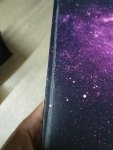Diwakar
Member
Greetings everybody !
We are new into paper based stationery manufacturing and recently started manufacturing perfect bound notebooks. We are noticing that lamination is coming out from the area near the spine where the edge is formed when notebook cover is turned.
Please refer to the screenshots.
Here are the specifications:
Pinter: Konica Minolta C258
Cover: 280 GSM Matte Art Card
Lamination: 25 micron matte (both sides)
Lamination Temperature: 130 degrees
We are using an automatic perfect binding machine and 12 inch roll-to-roll lamination machine. We also manufacture wireO notebooks and on those, the lamination is working perfectly fine.
Please advise as we have already tried various temperatures on lamination machine and we also tried creasing the cover before putting into the binding machine.
Thank you very much for your time and advice.
We are new into paper based stationery manufacturing and recently started manufacturing perfect bound notebooks. We are noticing that lamination is coming out from the area near the spine where the edge is formed when notebook cover is turned.
Please refer to the screenshots.
Here are the specifications:
Pinter: Konica Minolta C258
Cover: 280 GSM Matte Art Card
Lamination: 25 micron matte (both sides)
Lamination Temperature: 130 degrees
We are using an automatic perfect binding machine and 12 inch roll-to-roll lamination machine. We also manufacture wireO notebooks and on those, the lamination is working perfectly fine.
Please advise as we have already tried various temperatures on lamination machine and we also tried creasing the cover before putting into the binding machine.
Thank you very much for your time and advice.














